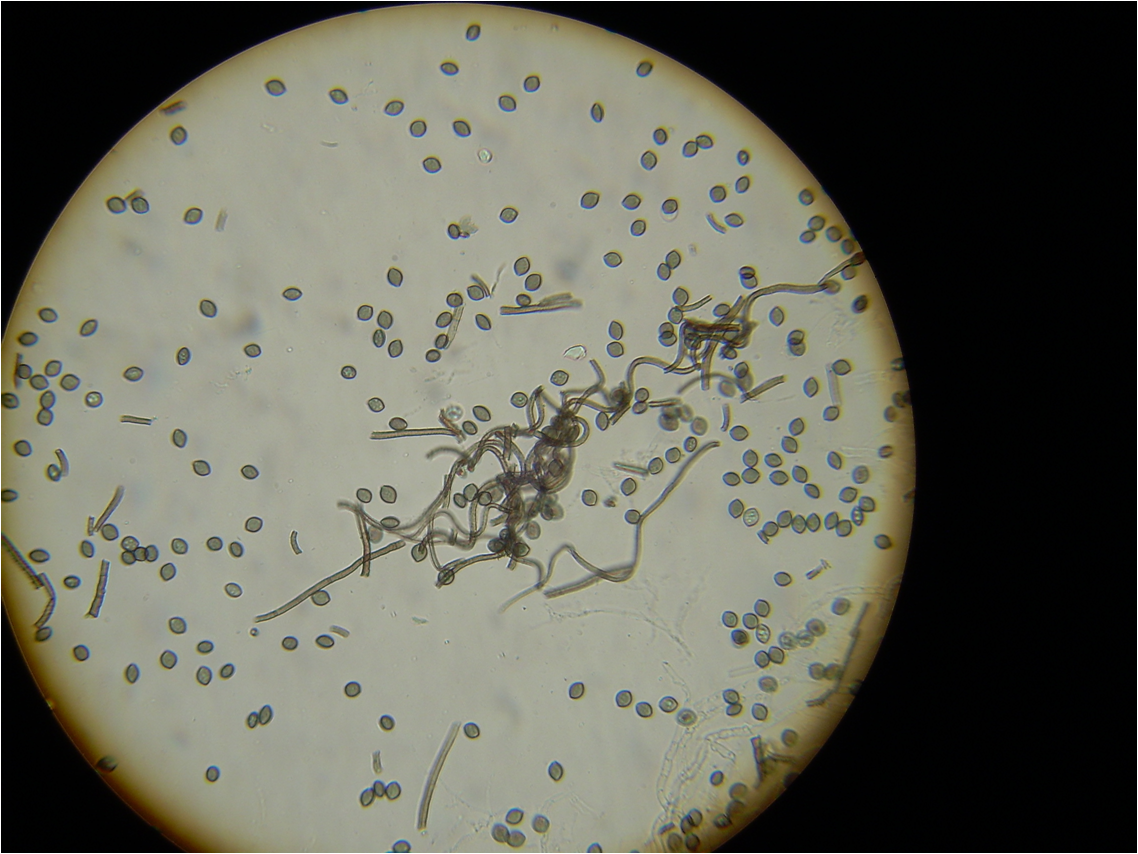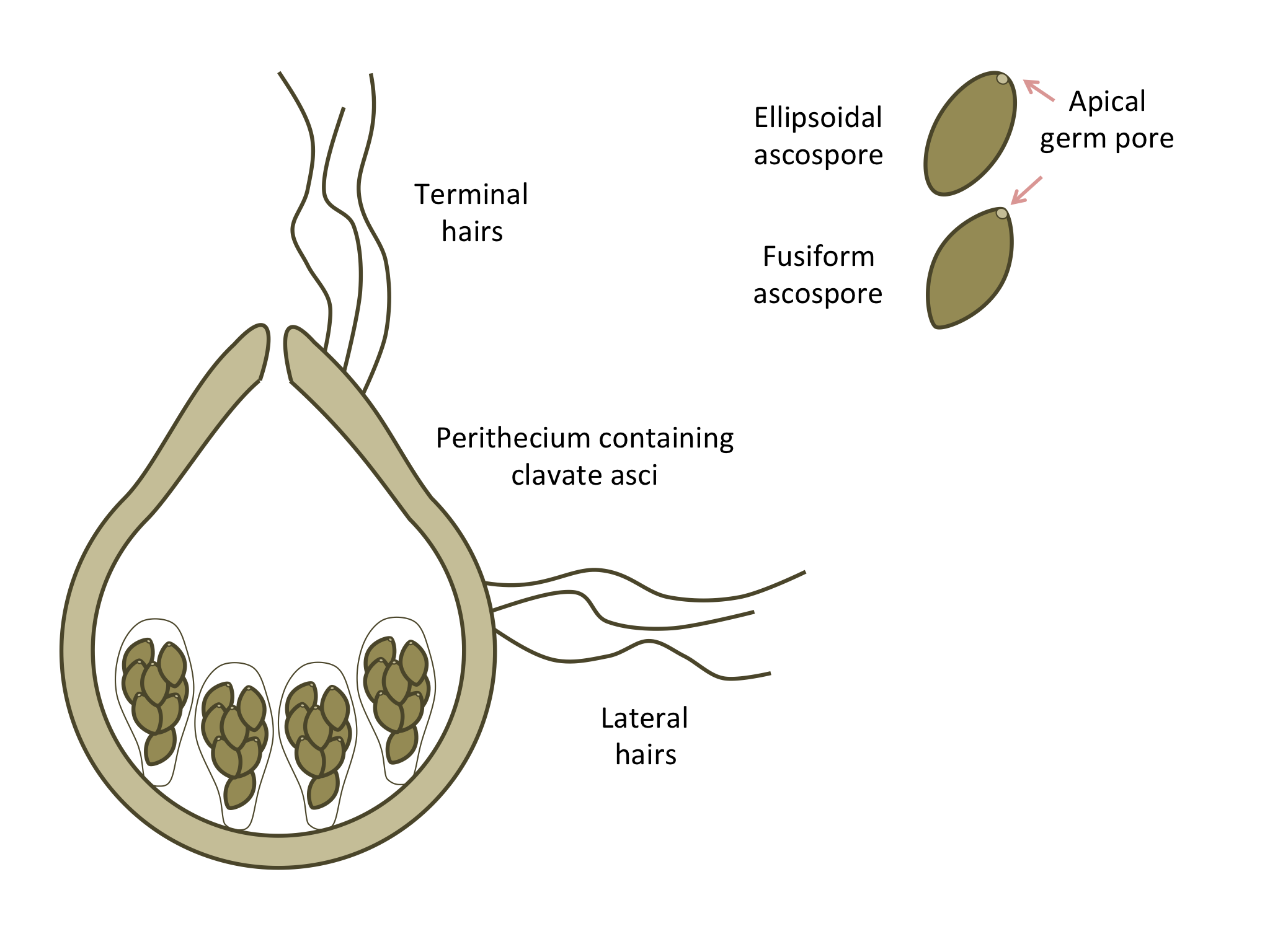Chaetomium Strumarium on:
[Wikipedia]
[Google]
[Amazon]
 ''Chaetomium'' is a
''Chaetomium'' is a  Members of this genus typically have superficial, ostiolar perithecia, covered in hairs. Asci are often clavate and evanescent, bearing eight spores. Ascospores are usually lemon-shaped, commonly colored olive-brown. Mycelia often grows in conglomerate masses that resemble ropes.Chivers, A. H. (1915). "A monograph of the genera ''Chaetomium'' and ''Ascotricha''". ''Mem. Torrey Bot. Club'' 14: 155-240.
As well as being a contaminant, ''Chaetomium'' spp. are also encountered as causative agents of infections in humans. Many cases cause type 1 allergic reactions and infections. A few cases of fatal deep infections due to ''Chaetomium atrobrunneum'' have been reported in immunocompromised people. Other clinical syndromes include brain abscess,
Members of this genus typically have superficial, ostiolar perithecia, covered in hairs. Asci are often clavate and evanescent, bearing eight spores. Ascospores are usually lemon-shaped, commonly colored olive-brown. Mycelia often grows in conglomerate masses that resemble ropes.Chivers, A. H. (1915). "A monograph of the genera ''Chaetomium'' and ''Ascotricha''". ''Mem. Torrey Bot. Club'' 14: 155-240.
As well as being a contaminant, ''Chaetomium'' spp. are also encountered as causative agents of infections in humans. Many cases cause type 1 allergic reactions and infections. A few cases of fatal deep infections due to ''Chaetomium atrobrunneum'' have been reported in immunocompromised people. Other clinical syndromes include brain abscess,
 ''Chaetomium'' is a
''Chaetomium'' is a genus
Genus ( plural genera ) is a taxonomic rank used in the biological classification of extant taxon, living and fossil organisms as well as Virus classification#ICTV classification, viruses. In the hierarchy of biological classification, genus com ...
of fungi in the Chaetomiaceae
The Chaetomiaceae (Index Fungorum number: IF80582) are a family of fungi in the Ascomycota, order Sordariales, class Sordariomycetes. Chaetomiaceae are usually saprobic or parasitic. Cheatomiaceae are a great source of enzymes with diverse biotec ...
family. It is a dematiaceous (dark-walled) mold
A mold () or mould () is one of the structures certain fungus, fungi can form. The dust-like, colored appearance of molds is due to the formation of Spore#Fungi, spores containing Secondary metabolite#Fungal secondary metabolites, fungal seco ...
normally found in soil, air, cellulose and plant debris. According to the ''Dictionary of the Fungi'' (10th edition, 2008), there are about 95 species in the widespread genus.
In 1817 Gustav Kunze
Gustav Kunze (4 October 1793, Leipzig – 30 April 1851, Leipzig)
was a German professor of zoology, an entomologist and botanist with an interest mainly in ferns and orchids.
Kunze joined the Wernerian Natural History Society in Edinburgh in 181 ...
established the genus ''Chaetomium'' (the plume of the helmet) to classify the species ''C. globosum'' and ''C. elatum''. No further contributions to the genus were made until 1837 when the publication of Corda described its characteristic asci in his work, ''Icones Fungorum Hucusque Cognitorum''. In 1915, Arthur Houston Chivers produced a complete monographic treatment of the genus, recognizing only 28 of the described 114 species.
 Members of this genus typically have superficial, ostiolar perithecia, covered in hairs. Asci are often clavate and evanescent, bearing eight spores. Ascospores are usually lemon-shaped, commonly colored olive-brown. Mycelia often grows in conglomerate masses that resemble ropes.Chivers, A. H. (1915). "A monograph of the genera ''Chaetomium'' and ''Ascotricha''". ''Mem. Torrey Bot. Club'' 14: 155-240.
As well as being a contaminant, ''Chaetomium'' spp. are also encountered as causative agents of infections in humans. Many cases cause type 1 allergic reactions and infections. A few cases of fatal deep infections due to ''Chaetomium atrobrunneum'' have been reported in immunocompromised people. Other clinical syndromes include brain abscess,
Members of this genus typically have superficial, ostiolar perithecia, covered in hairs. Asci are often clavate and evanescent, bearing eight spores. Ascospores are usually lemon-shaped, commonly colored olive-brown. Mycelia often grows in conglomerate masses that resemble ropes.Chivers, A. H. (1915). "A monograph of the genera ''Chaetomium'' and ''Ascotricha''". ''Mem. Torrey Bot. Club'' 14: 155-240.
As well as being a contaminant, ''Chaetomium'' spp. are also encountered as causative agents of infections in humans. Many cases cause type 1 allergic reactions and infections. A few cases of fatal deep infections due to ''Chaetomium atrobrunneum'' have been reported in immunocompromised people. Other clinical syndromes include brain abscess, peritonitis
Peritonitis is inflammation of the localized or generalized peritoneum, the lining of the inner wall of the abdomen and cover of the abdominal organs. Symptoms may include severe pain, swelling of the abdomen, fever, or weight loss. One part or ...
, and onychomycosis
Onychomycosis, also known as tinea unguium, is a fungal infection of the nail. Symptoms may include white or yellow nail discoloration, thickening of the nail, and separation of the nail from the nail bed. Toenails or fingernails may be affected ...
.
Selected species
*''Chaetomium atrobrunneum
''Chaetomium atrobrunneum'' is a darkly pigmented mould affiliated with the fungal division, Ascomycota. This species is predominantly saprotrophic, although it has been known to infect animals including humans, showing a proclivity for the tiss ...
''
*''Chaetomium carinthiacum
''Chaetomium'' is a genus of fungi in the Chaetomiaceae family. It is a dematiaceous (dark-walled) mold normally found in soil, air, cellulose and plant debris. According to the ''Dictionary of the Fungi'' (10th edition, 2008), there are about ...
''
*''Chaetomium cupreum
''Chaetomium cupreum'' is a fungus in the family Chaetomiaceae. It is able to decay in manufactured cellulosic materials, and is known to antagonize a wide range of soil microorganisms. This species is component of the biocontrol agent, Ketomium ...
''
*''Chaetomium cellulolyticum
''Chaetomium cellulolyticum'' is a fungus in the genus ''Chaetomium''. It is associated with the production of cellulase.
References
Chaetomium, cellulolyticum
Taxa named by David Leslie Hawksworth
{{Sordariales-stub ...
''
*''Chaetomium elatum
''Chaetomium elatum'' is a very common and widely distributed saprotrophic fungus of the Chaetomiaceae family of molds which has been found to grow on many different substances all over the world. It was first established by Gustav Kunze after ...
''
*''Chaetomium funicola
''Chaetomium'' is a genus of fungi in the Chaetomiaceae family. It is a dematiaceous (dark-walled) mold normally found in soil, air, cellulose and plant debris. According to the ''Dictionary of the Fungi'' (10th edition, 2008), there are about ...
''
*''Chaetomium globosum
''Chaetomium globosum'' is a well-known mesophilic member of the mold family Chaetomiaceae. It is a saprophytic fungus that primarily resides on plants, soil, straw, and dung. Endophytic ''C. globosum'' assists in cellulose decomposition of plan ...
''
*'' Chaetomium grande''
*''Chaetomium interruptum
''Chaetomium interruptum'' is a fungus species in the ''Chaetomium'' genus, first isolated from Iran. It shares features such as peridium structure, ascospore morphology and germ pore
A germ pore is a small pore in the outer wall of a fungal sp ...
''
*'' Chaetomium iranianum''
*''Chaetomium jatrophae
''Chaetomium'' is a genus of fungi in the Chaetomiaceae family. It is a dematiaceous (dark-walled) mold normally found in soil, air, cellulose and plant debris. According to the ''Dictionary of the Fungi'' (10th edition, 2008), there are about ...
''
*''Chaetomium megalocarpum
''Chaetomium'' is a genus of fungi in the Chaetomiaceae family. It is a dematiaceous (dark-walled) mold normally found in soil, air, cellulose and plant debris. According to the ''Dictionary of the Fungi'' (10th edition, 2008), there are about ...
''
*''Chaetomium perlucidum
''Chaetomium perlucidum'' is a neurotropic dematiaceous (melanated cell wall) fungus that is naturally found in the soil, including in agricultural soil, and in the stems of dead plants. The fungus can also be found on the feathers of birds, man ...
''
*''Chaetomium rectangulare
''Chaetomium rectangulare'' is a fungus species in the Chaetomium genus, first isolated from Iran. It shares features such as peridium structure, ascospore morphology and germ pore position with its cogenerates. It is closely related to ''Chaetom ...
''
*''Chaetomium strumarium
''Chaetomium'' is a genus of fungi in the Chaetomiaceae family. It is a dematiaceous (dark-walled) mold normally found in soil, air, cellulose and plant debris. According to the ''Dictionary of the Fungi'' (10th edition, 2008), there are about ...
''
*''Chaetomium subspirale
''Chaetomium subspirale'' is a fungus from the phylum Ascomycota. It was described by A. H. Chivers in 1912 in America. The species has sexual fruiting bodies that are ornamented with characteristic, coiled hairs giving it a wooly appearance. ''C ...
''
*''Chaetomium thermophilum
''Chaetomium thermophilum'' is a thermophilic filamentous fungus. It grows on dung or compost (rotten organics). It is notable for being a eukaryote with a high temperature tolerance (60 °C). Its optimal growth temperature is 50–55 ...
''
*''Chaetomium truncatulum
''Chaetomium truncatulum'' is a fungus species in the ''Chaetomium'' genus, first isolated from Iran. It shares features such as peridium structure, ascospore morphology and germ pore position with its cogenerates. This species in particular can ...
''
*''Chaetomium olivaceum
''Chaetomium'' is a genus of fungi in the Chaetomiaceae family. It is a dematiaceous (dark-walled) mold normally found in soil, air, cellulose and plant debris. According to the ''Dictionary of the Fungi'' (10th edition, 2008), there are about ...
''
*''Chaetomium undulatulum
''Chaetomium undulatulum'' is a fungus species in the ''Chaetomium'' genus, first isolated from Iran. It shares features such as peridium structure, ascospore morphology and germ pore
A germ pore is a small pore in the outer wall of a fungal sp ...
''
References
Sordariomycetes genera {{Sordariales-stub